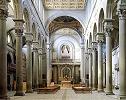Realistic Spatial Perspective |
Realistic Spatial Perspective |

|
Donatello Feast of Herod gilded bronze relief, 1423-25 |
|

|
This small relief is thought to be the first example of true one-point perspective; although classical artists used aerial perspective--which gives an illusion of space, they did not understand mathematical perspective. Arranging figures in a convincing space is yet another realistic device. |
|
Masaccio Trinity fresco, 1428 Santa Maria Novello, Florence |
|

|
Masaccio's large fresco gives an illusionistic representation of space, employing the Renaissance discovery of one-point perspective. From an appropriate distance and angle, the painted architecture is so "real" that it tricks viewers into thinking that they are looking down an actual hall. When the fresco was first unveiled, viewers reportedly gasped in suprise and amazement. |
|
Raphael Betrothal of the Virgin 1504 |
|

|
The High Renaissance artist, Raphael, took spatial illusion a step further by arranging figures in the foreground, middleground, and background. The painting leads the viewer's eye into the distance in a rational way. Even the lines in the pavement lead the eye backward. Order, clarity, and stability are important traits in High Renaissance works. |
|
Brunelleschi San Lorenzo from 1420 Florence, Italy |
|

|
Art historians generally believe that the development of mathematical, one-point perspective was Brunelleschi's invention. Perspective drawings were an enormous aid to architects in the design of a building since they could convey a sense of the whole. Whereas many architects contributed to the design of medieval cathedrals, Renaissance churches can be attributed to one architect who had control over the entire design. (Renaissance churches are also much smaller than Gothic cathedrals.)
This church has a sense of a whole, focussing the eye on the altar. The entablature above the arches, the steady march of the arches down the nave, and the patterning on the floor converge at the altar. Notice too that this church is much closer to an early Christian basilica, which also used classical details, than a Gothic cathedral.
|
All images marked MAS were photographed on location by Mary Ann Sullivan. All other images were scanned from other sources or downloaded from the World Wide Web; they are posted on this password-protected site for educational purposes, at Bluffton College only, under the "fair use" clause of U.S. copyright law.